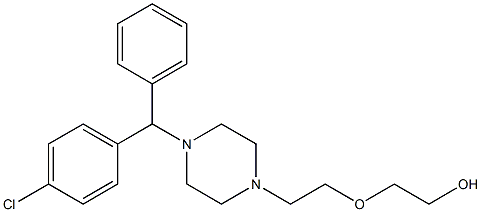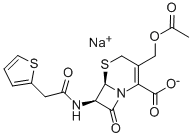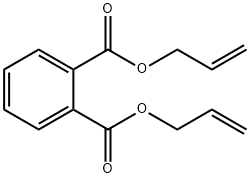Tiagabine
- CAS NO.:115103-54-3
- Empirical Formula: C20H25NO2S2
- Molecular Weight: 375.55
- MDL number: MFCD00865317
- SAFETY DATA SHEET (SDS)
- Update Date: 2024-11-19 23:02:33

What is Tiagabine?
Absorption
Tiagabine is nearly completely absorbed (>95%).
Toxicity
mptoms most often accompanying tiagabine overdose, alone or in combination with other drugs, have included: seizures including status epilepticus in patients with and without underlying seizure disorders, nonconvulsive status epilepticus, coma, ataxia, confusion, somnolence, drowsiness, impaired speech, agitation, lethargy, myoclonus, spike wave stupor, tremors, disorientation, vomiting, hostility, and temporary paralysis. Respiratory depression was seen in a number of patients, including children, in the context of seizures.
Description
Gabitril was launched in Denmark for use as an add-on therapy in patients refractory to other epilepsy therapies. The compound can be synthesized in five steps beginning with a bis-thiophenyl ketone derivative to produce the (R)-(-)- enantiomer. Its anti-epileptic activity resides in its potent and selective inhibition of GABA synaptosomal uptake. Tiagabine is selective for the GAT-1 GABA transporter in neurons and glia thus enhancing inhibitory GABAergic transmission. Because it has practically no effect on other uptake or receptor systems, it has a reduced potential for neurological side-effects. In particular, it does not have the benzodiazepine-like sedative effects. It is able to cross the blood brain barrier and is considered the most potent GABA uptake inhibitor known.
Chemical properties
White to Off-White Crystalline Solid
Originator
Novo Nordisk (Denmark)
The Uses of Tiagabine
A GABA uptake inhibitor
Background
Tiagabine is an anti-convulsive medication. It is also used in the treatment for panic disorder as are a few other anticonvulsants. Though the exact mechanism by which tiagabine exerts its effect on the human body is unknown, it does appear to operate as a selective GABA reuptake inhibitor.
Indications
For the treatment of partial seizures
Definition
ChEBI: A piperidinemonocarboxylic acid that is (R)-nipecotic acid in which the hydrogen attached to the nitrogen has been replaced by a 1,1-bis(3-methyl-2-thienyl)but-1-en-4-yl group. A GABA reuptake inhibitor, it is used (generally as the hydroc loride salt) for the treatment of epilepsy.
Manufacturing Process
A solution of 34 ml of n-butyl lithium in 30 ml of anhydrous ether was cooled
to -65°C under nitrogen and 5.3 ml of 3-methyl-2-bromothiophene in 10 ml
anhydrous ether was added dropwise over a period of 10 min. The reaction
mixture was stirred at -65°C for 1 h and 2.7 ml of ethyl 4-bromo-butyrate in
10 ml of anhydrous ether was added slowly. The reaction was stirred for 4 h
while the temperature raised to -20°C, 20 ml water was added, and the
mixture was stirred for 5 min after which the aqueous layer was removed. The
ether layer was washed with 20 ml of water, and the combined aqueous
phases were extracted with 50 ml of ether. The combined organic phases were
dried over anhydrous sodium sulfate, which after evaporation yielded 9 g of 1-
bromo-4,4-bis(3-methylthien-2-yl)but-3-ene as an oil.
This compound was without further purification used for coupling with ethyl
nipecotate.
A suspension of 5.0 g of 1-bromo-4,4-bis(3-methylthien-2-yl)but-3-ene, 3.4 g
of nipecotic acid ethyl ester and 3.3 g of potassium carbonate in 150 ml of dry
acetone was kept under reflux for 15 h. The reaction mixture was evaporated
and, after addition of 30 ml of water, the resulting solution was extracted
twice with 50 ml of ethyl acetate. The ethyl acetate extracts were dried and
evaporated leaving 7.3 g of an oil. By column chromatography on silica gel
using methanol as eluent, N-(4,4-bis(3-methylthien-2-yl)but-3-enyl)nipecotic
acid ethyl ester was isolated.
5.3 g of N-(4,4-bis(3-methylthien-2-yl)but-3-enyl)nipecotic acid ethyl ester
was dissolved in 100 ml of ethanol and 200 ml of an 8 N sodium hydroxide
solution was added. The mixture was heated at reflux for 1 h, cooled and
acidified by adding 10% hydrochloric acid. The resulting solution was
evaporated and 100 ml of water was added to the residue. The resulting acid
solution was extracted with ethyl acetate and the dried extract was
evaporated to give (R)-N-(4,4-bis(3-methylthien-2-yl)but-3-enyl)nipecotic acid
hydrochloride, melting point 187°-189°C.
brand name
Gabitril
Therapeutic Function
Antiepileptic
Biological Functions
Tiagabine (Gabitril) blocks the reuptake of GABA into neurons and glia, thereby resulting in higher levels of GABA in the synaptic cleft. The ability to increase GABA concentrations is presumed to be involved in the effectiveness of tiagabine in the treatment of seizure disorders. It is primarily used in the treatment of partial complex seizures.Adverse effects of tiagabine administration include dizziness, somnolence, nervousness, nausea, and confusion.
General Description
A glance at tiagabine’s structure suggests anuptake inhibitor. Reportedly, it blocks GABA reuptake asa major mode of its anticonvulsant activity. Its use isagainst partial seizures. Inhibitors of GABA transporter-1(GAT-1 inhibitors) increase extracellular GABA concentrationin the hippocampus, striatum, and cortex, therebyprolonging the inhibitory action of GABA released synaptically.Nipecotic acid is a potent inhibitor of GABA reuptakeinto synaptosomal membranes, neurons, and glialcells. However, nipecotic acid fails to cross the blood-brainbarrier following systemic administration because of itshigh degree of ionization. Tiagabine, marketed as thesingle R(-)-enantiomer, a potent GAT-1 inhibitor structurallyrelated to nipecotic acid, has an improved ability tocross the blood-brain barrier, and it has recently receivedFood and Drug Administration (FDA) approval as anAED.It is well absorbed and readily metabolized byCYP3A4 to an inactive metabolite, 5-oxo-tiagabine (oxidationof the thiophen ring) or eliminated as glucuronide ofthe parent molecule.
Over 90% of tiagabine is metabolized by CYP3A4isozymes.The primary site of metabolic attack is the oxidationof the thiophen rings leading to 5-oxo-tiagabine thatlacks anticonvulsant activity and the glucuronidation via thecarboxylic function. Thus, the plasma concentrations oftiagabine would be greatly effected by any compound thatinduces or inhibits CYP3A4.
Mechanism of action
Tiagabine is a nipecotic acid derivative with an improved ability to cross the blood-brain barrier. It was rationally designed to be a GABA uptake inhibitor based on the fact that nipecotic acid (piperidine-3-carboxylic acid) inhibits GABA uptake by glial cells. Tiagabine binds to the GABA transporter GAT1, blocking the uptake of GABA into both neurons and glia, thus enhancing GABA-mediated inhibition. Tiagabine is presently approved for adjunct use in patients with epilepsy who are older than 12 years and have partial seizures not controlled by first-line drugs.
Pharmacokinetics
Tiagabine is used primarily as an anticonvulsant for the adjunctive treatment of epilepsy. The precise mechanism by which Tiagabine exerts its antiseizure effect is unknown, although it is believed to be related to its ability to enhance the activity of gamma aminobutyric acid (GABA), the major inhibitory neurotransmitter in the central nervous system. Tiagabine binds to recognition sites associated with the GABA uptake carrier. It is thought that, by this action, Tiagabine blocks GABA uptake into presynaptic neurons, permitting more GABA to be available for receptor binding on the surfaces of post-synaptic cells.
Pharmacokinetics
Tiagabine is well absorbed, with an oral bioavailability of 90 to 95%. It displays linear pharmacokinetics, with a plasma half-life of 5 to 8 hours, necessitating a multiple daily dosing regimen. It also is highly protein bound (96%). The major pathway of metabolism for tiagabine is oxidation by CYP3A4, followed by glucuronidation. Its pharmacokinetics are altered by the coadministration of enzyme-inducing AEDs, even though tiagabine does not appear to induce or inhibit hepatic microsomal metabolizing enzymes.
Clinical Use
Antiepileptic
Side Effects
Side effects are more common with tiagabine than with other adjunct drugs and most often involve the CNS. They include
somnolence, headache, dizziness, tremor, abnormal thinking, depression, and psychosis. Furthermore, recent reports have
implicated tiagabine in the development of nonconvulsive status epilepticus. There is an increased risk of seizure in
patients being treated for off-label psychiatric indications. Tiagabine may interfere with visual color perception.
Tiagabine does not affect the hepatic metabolism of other AEDs, but its half-life is decreased by enzyme-inducing AEDs, such
as CBZ, phenytoin, and barbiturates. Other CYP3A4-inducing drugs may act similarly. Valproate decreases the protein binding
of tiagabine. increasing its plasma concentration in these patients.
Hepatic disease causes decreased clearance of tiagabine, and a dose reduction may be required. Renal disease does not
affect elimination.
Drug interactions
Potentially hazardous interactions with other drugs
Antidepressants: antagonism of anticonvulsant effect with SSRIs, tricyclics and MAOIs (convulsive threshold lowered); avoid with St John’s wort.
Antiepileptics: concentration reduced by phenytoin, carbamazepine and phenobarbital.
Antimalarials: mefloquine antagonises anticonvulsant.
Antipsychotics: anticonvulsant effect antagonised.
Orlistat: possibly increased risk of convulsions.
Metabolism
Tiagabine is likely metabolized primarily by the 3A isoform subfamily of hepatic cytochrome P450.
Metabolism
Tiagabine has negligible renal clearance. Hepatic metabolism is the principle route for elimination of tiagabine. Less than 2
% of the dose is excreted unchanged in urine and faeces. No active metabolites have been identified.
Properties of Tiagabine
| Melting point: | 192oC dec. |
| Boiling point: | 568.0±50.0 °C(Predicted) |
| Density | 1.208±0.06 g/cm3(Predicted) |
| storage temp. | under inert gas (nitrogen or Argon) at 2-8°C |
| pka | 3.86±0.20(Predicted) |
| Water Solubility | ≥ 13.5mg/mL in Water |
| CAS DataBase Reference | 115103-54-3(CAS DataBase Reference) |
Safety information for Tiagabine
| Signal word | Warning |
| Pictogram(s) |
 Exclamation Mark Irritant GHS07 |
| GHS Hazard Statements |
H315:Skin corrosion/irritation H319:Serious eye damage/eye irritation H335:Specific target organ toxicity, single exposure;Respiratory tract irritation |
| Precautionary Statement Codes |
P261:Avoid breathing dust/fume/gas/mist/vapours/spray. P305+P351+P338:IF IN EYES: Rinse cautiously with water for several minutes. Remove contact lenses, if present and easy to do. Continuerinsing. |
Computed Descriptors for Tiagabine
Tiagabine manufacturer
SMS Lifesciences India Ltd (MAHI Drugs Pvt Ltd)
New Products
(S)-3-Aminobutanenitrile hydrochloride 4-Methylphenylacetic acid N-Boc-D-alaninol N-BOC-D/L-ALANINOL Tert-butyl bis(2-chloroethyl)carbamate 3-Morpholino-1-(4-nitrophenyl)-5,6-dihydropyridin- 2(1H)-one Furan-2,5-Dicarboxylic Acid Tropic acid 1-Bromo-3,5-Di-Tert-Butylbenzene S-2-CHLORO PROPIONIC ACID ETHYL ISOCYANOACETATE 2-Bromo-1,3-Bis(Dimethylamino)Trimethinium Hexafluorophosphate 4-IODO BENZOIC ACID 3-NITRO-2-METHYL ANILINE 1-(2,4-DICHLOROPHENYL) ETHANAMINE (2-Hydroxyphenyl)acetonitrile 4-Bromopyrazole 2-(Cyanocyclohexyl)acetic acid 4-methoxy-3,5-dinitropyridine 1-(4-(aminomethyl)benzyl)urea hydrochloride 2-aminopropyl benzoate hydrochloride diethyl 2-(2-((tertbutoxycarbonyl)amino) ethyl)malonate tert-butyl 4- (ureidomethyl)benzylcarbamate Ethyl-2-chloro((4-methoxyphenyl)hydrazono)acetateRelated products of tetrahydrofuran








You may like
-
 115103-54-3 / 109857-64-9 Tiagabine 98%View Details
115103-54-3 / 109857-64-9 Tiagabine 98%View Details
115103-54-3 / 109857-64-9 -
 2033-24-1 98%View Details
2033-24-1 98%View Details
2033-24-1 -
 1975-50-4 98%View Details
1975-50-4 98%View Details
1975-50-4 -
 2-HYDROXY BENZYL ALCOHOL 98%View Details
2-HYDROXY BENZYL ALCOHOL 98%View Details
90-01-7 -
 2-Chloro-1,3-Bis(Dimethylamino)Trimethinium Hexafluorophosphate 221615-75-4 98%View Details
2-Chloro-1,3-Bis(Dimethylamino)Trimethinium Hexafluorophosphate 221615-75-4 98%View Details
221615-75-4 -
 61397-56-6 CIS BROMO BENZOATE 98%View Details
61397-56-6 CIS BROMO BENZOATE 98%View Details
61397-56-6 -
 14714-50-2 (2-Hydroxyphenyl)acetonitrile 98+View Details
14714-50-2 (2-Hydroxyphenyl)acetonitrile 98+View Details
14714-50-2 -
 118753-70-1 98+View Details
118753-70-1 98+View Details
118753-70-1